市场资讯及洞察
%20(1).jpg)
好久不写文章了,重新到电脑前找感觉,果然还是验证之前小时候的那句话,一天不练自己知道,三天不练同行知道,十天不练观众也知道。虽然平时事情太多,但是为了给新来的同事们树立榜样,再忙我也可以做到一周一篇,其他人就不能找借口。所以我必须以身作则。
言归正传,最近墨尔本很不太平,不仅仅是各种偷盗,当街伤人事件层出不穷。更严重的是每个月几乎都有大规模的反移民游行抗议。这是非常危险的信号,虽然澳洲主流阶层和过去30年买房的既得利益者都因为大量移民的获利丰厚,但是更多的底层民众,没有买房的,或者还在租房的人群,却的的确确因为不断上涨的住房成本和不断上涨的生活成本而举步艰难。
墨尔本,这个曾经连续多年全球最适宜居住城市,在过去的5年却经历了惊人的倒退。由于州政府巨大的债务欠款,导致过去几年整个州的财政都围绕着尽快还清欠款的主题在制定政策:从翻倍的地税,到增加的企业工资税,到为了还债而减少的公共投入,以及过于宽松的青少年保释政策,使得墨尔本的整体经商,就业和居住环境出现了明显的恶化。以房价举例,作为澳洲第二大城市墨尔本,其平均房价现在居然还低于了更小的城市布里斯班和阿德雷德,这种短期的价格倒挂无疑就是在讽刺维州当局。连澳洲的投资者都逃离墨尔本,还不能说明问题吗?当然咱们今天的内容不是喷社会问题,抱怨了一大堆,内心增加负能量,还得我自己消化。不划算。
言归正传,澳洲最大的财经媒体AFR,在上周四发表了一篇文章,基本意思就是,澳洲最新出台的就业数据太差,基本注定了澳洲央行距离降息不远了。

根据澳洲统计数数据,澳洲9月的失业率从之前的4.2%骤然上升到了4.5%,短期的严重恶化,可能会使得澳洲央行原本准备稳定慢慢降息的计划被再次打乱。
大家可以参考我过去几个月甚至去年的文章,其实我本人一直认为,并且坚持我的观点,就是澳洲的物价并没有怎么好转。不论是买菜,吃饭,手机电器,还是娱乐消费,旅游,开车汽油保险,以及租房建房。所有澳洲统计局在计算物价时会参考的项目,我看了一遍,价格上涨幅度就几乎没有低于10%的。更别说这每天喝的咖啡了,墨尔本CBD一杯咖啡你要是选豆奶的,很多咖啡店都快7澳元了,这样的情况下,你告诉我物价控制住了?当然,政府为了给央行台阶下,也非常配合的出台了每家每年300澳元的电费减免计划,直接从统计数据里花钱作弊。这种自欺欺人的做法真的让我非常无语。
然后呢?4次补贴用完以后,电费还不是越来越高?煤气费更是翻天了。这种情况下,你告诉我物价控制住了,没事了?咱们是活在电视剧里吗?
当然,咱们知道这个世界不可能完美。澳洲央行和澳洲各界政府在做每个决定时我们也相信他们是抱着很好的愿景和希望的。只是结果没有达到预期。那么现在澳洲央行对比一年前那是还较为强劲的经济表现,现在应该说他们的决定更为艰难:
4.5%的失业率其实是一个明显的信号:企业招人少了,因为企业觉得未来不确定,甚至觉得未来可能会更不好,因此要节约开支,少招人。而不断增加的失业率,也将给目前依然在工作的人一个信号:外面的环境不好,不要轻易辞职,花钱要更谨慎。如此长期一来肯定会减少消费,帮助缓解通胀。
但是,在另一方面,即使在当前的利息下,悉尼和墨尔本的拍卖率又重新回到了80%甚至更高,这也意味着已经非常高的房价可能会再次上涨。这对于原本就因为生活成本高企而抱怨新移民的那批民众更加痛恨移民:他们会觉得是新移民抢走了工作,抢走了住房,抢走了一切。
但是他们忘记了自己的祖上曾经也是澳洲移民大军中的一员。在澳洲,除了本地的原住民,大家都是移民。我们不能因为自己移民了,就不让别人上车。澳洲的繁荣和发展,正是靠着不断增加的移民所带动的。在过去20年的历次金融危机中,只有澳洲是发达国家里唯一没有明显衰退的幸运儿。而其原因,就是靠着每次巨大的移民放水,通过直接提高社会住房,消费和物质需求来抵消金融危机带来的恐慌和消费紧缩。
扯远了,我要说的是,现在澳洲央行面临更加困难的情况:
1. 经济似乎在变差,失业率增加,国际局势以及铁矿石需求都对澳洲不利,这时理论上就需要通过降息来刺激消费,刺激经济,恢复市场信心。从这方面看,澳洲需要降息。
2. 但是物价还太高,根本没怎么下降。房价却还在上涨,如果再次降息,房价会上涨的更快,这样一来社会矛盾会更加尖锐,物价也更难回归正常。现任央行女行长是财政部长一手提拔的,或者说是超规格提拔的,因此她也在尽可能的配合联邦政府的经济政策。因此在目前社会矛盾尖锐,贫富差距进一步扩大,选民愤怒的情况下,似乎选择不降息也是正确选择。
那在左右为难的情况下,央行会怎么做?
我怎么知道,我又不是他们的蛔虫。但是这不妨碍我们瞎扯和猜。还是那句话,不论哪个专家哪个首席,归根结底都是猜。无非就是名头响亮的猜。
如果我是央行行长,在当前情况下,我不会选择马上降息。因为第一,即使我降息了,也无法改变国际环境:啥国际环境?中美贸易扯皮,中国对铁矿石需求降低,美国要澳洲站队,这个大环境短期不会变。就算澳洲把利息降到0,如果铁矿石卖不出去,那经济还是会受挫。所以如果降息不能直接,马上,立即刺激经济的话,我就会考虑另一个选择:不降息,可以带来什么好处?
1. 控制依然很高的物价,至少不会继续上涨。给普通大众生活成本带来一线改善,不要再激化社会矛盾。
2. 控制反弹过快的房价,这个不仅有利于缓解民间矛盾,更重要的是可以赢得选票。
那如果不降息,经济怎么办?
这时就要靠财政部长去说服总理,在移民闸口上送一下,靠100%新刚需来给帮澳洲撑一下。
所以总结来说,也许我判断有误,但是如果我是行长,在综合考虑各种利弊的情况下,我不会马上降息,而是会继续等待更多的数据和中美谈判结果,再做考虑。
而下一个话题,如果澳洲不马上降息,是不是意味着澳元不会继续下跌了?
答案是,你想多了,我依然坚持我从年初以来的看法:澳元和美元在未来很长一段时间,都会保持弱势。为啥?因为澳元看三个因素:铁矿石 价格,中国经济,和美元政策。什么时候中国的房价重新大规模反弹了,那澳元的长期走势就会重新开始上涨。
免责声明:GO Markets 分析师或外部发言人提供的信息基于其独立分析或个人经验。所表达的观点或交易风格仅代表其个人;并不代表 GO Markets 的观点或立场。
联系方式:
墨尔本 03 8658 0603
悉尼 02 9188 0418
中国地区(中文) 400 120 8537中国地区(英文) +248 4 671 903
作者:
Mike Huang | GO Markets 销售总监


S&P 500 and ASX Rally as Big Banks Drive Markets
Both the S&P 500 and ASX have rallied on the back of stronger-than-expected major bank earnings reports on both sides of the Pacific.
In the US, Bank of America reported a 31% year-over-year increase in earnings per share at $1.06, exceeding Wall Street's estimate of $0.95. Meanwhile, Morgan Stanley delivered a record-breaking quarter with EPS of $2.80, a nearly 49% increase from the same period last year.
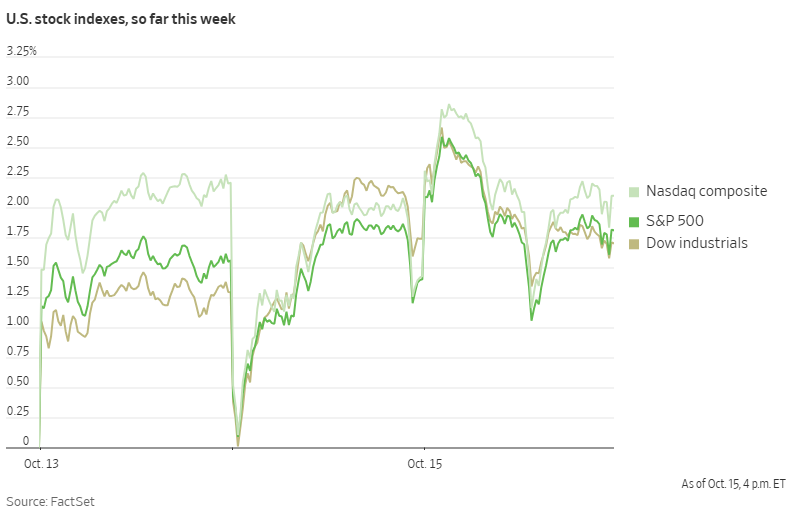
On the Australian front, the benchmark ASX 200 leapt 1.03% to 8990.99, with all four major Australian banks playing a major role. CBA closed 1.45% higher, Westpac 1.98%, NAB 1.87%, and ANZ 0.53%.
These strong bank results indicate broader economic strength, despite recent concerns about US-China trade tensions. US Treasury Secretary Scott Bessent emphasised that Washington did not want to escalate trade conflict with China and noted that President Trump is ready to meet Chinese President Xi Jinping in South Korea later this month.
With the third-quarter earnings season just getting underway, these early positive results from financial institutions could prove as the start of continued market strength through to the end of the year.
U.S. Government Shutdown Likely to Last Into November
Washington remains gridlocked as the U.S. enters its 16th day of shutdown. With no signs of compromise on the horizon, it appears increasingly likely the shutdown will extend into November and could even compromise the Thanksgiving holiday season.
Treasury Secretary Scott Bessent has warned "we are starting to cut into muscle here" and estimated "the shutdown may start costing the US economy up to $15 billion a day."
The core issue driving the shutdown is healthcare policy, specifically the expiring Affordable Care Act subsidies. Democrats are demanding these subsidies be extended, while Republicans argue this issue can be addressed separately from government funding.
The Trump administration has taken steps to blunt some of the shutdown's immediate impact, including reallocating funds to pay active-duty soldiers this week and infusing $300 million into food aid programs.
However, House Speaker Mike Johnson has emphasised these are merely "temporary fixes" that likely cannot be repeated at the end of October when the next round of military paychecks is scheduled.
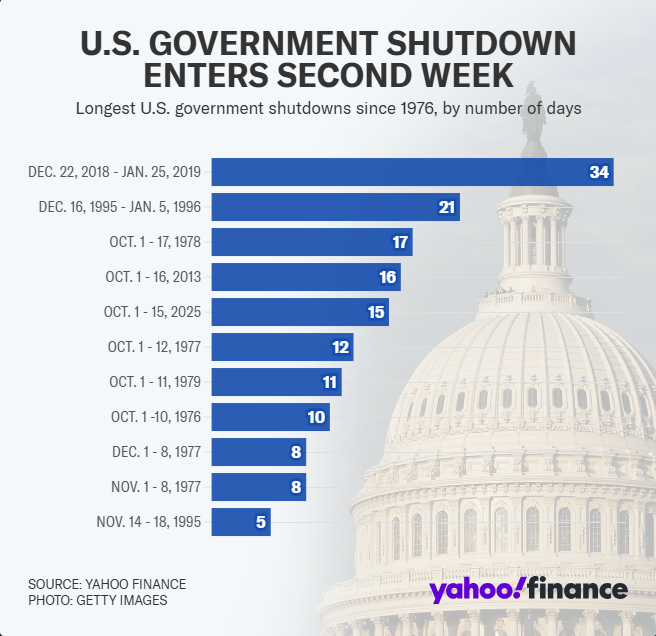
By the end of this week, this shutdown will become the third-longest in U.S. history. If it continues into November 4th, it will surpass the 34-day shutdown of 2018-2019 to become the longest government shutdown ever recorded.
This prolonged shutdown adds another layer of volatility to markets. While previous shutdowns have typically had limited long-term market impacts, the unprecedented length and timing of this closure, combined with its expanding economic toll, warrant closer attention as we move toward November.
Trump Announces Modi Has Agreed to Stop Buying Russian Oil
Yesterday, Trump announced that Indian Prime Minister Narendra Modi has agreed to stop purchasing Russian oil. He stated that Modi assured him India would halt Russian oil imports "within a short period of time," describing it as "a big step" in efforts to isolate Moscow economically.
The announcement comes after months of trade tensions between the US and India. In August, Trump imposed 50% tariffs on Indian exports to the US, doubling previous rates and specifically citing India's Russian oil purchases as a driving factor.

India has been one of Russia's top oil customers alongside China in recent years. Both countries have taken advantage of discounted Russian oil prices since the start of the Ukraine invasion.
Analysis suggests India saved between $2.5 billion to $12.6 billion since 2022 by purchasing discounted Russian crude compared to other sources, helping support its growing economy of 1.4 billion people.
Trump suggested that India's move would help accelerate the end of the Ukraine war, stating: "If India doesn't buy oil, it makes it much easier." He also mentioned his intention to convince China to follow suit: "Now I've got to get China to do the same thing."
The Indian embassy in Washington has not yet confirmed Modi's commitment. Markets will be closely watching for official statements from India and monitoring oil trading patterns in the coming weeks to assess the potential impact on global energy flows and prices.
Chart of the Day - Gold futures CFD (XAUUSD)


Most traders understand EA portfolio balance through the lens of traditional risk management — controlling position sizes, diversifying currency pairs, or limiting exposure per trade.
But in automated trading, balance is about deliberately constructing a portfolio where different strategies complement each other, measuring their collective performance, and actively managing the mix based on those measurements.
The goal is to create a “book” of EAs that can help diversify performance over time, even when individual strategies hit rough patches.
A diversified mix of EAs across timeframes and assets can, in some cases, reduce reliance on any single strategy. This approach reduces dependency on any single EA’s performance, smooths your overall equity curve, and builds resilience across changing market conditions.
It’s about running the right mix, identifying gaps in your coverage, and viewing your automated trading operation as an integrated whole rather than a collection of independent systems.
Basic Evaluation Metrics – Your Start Point
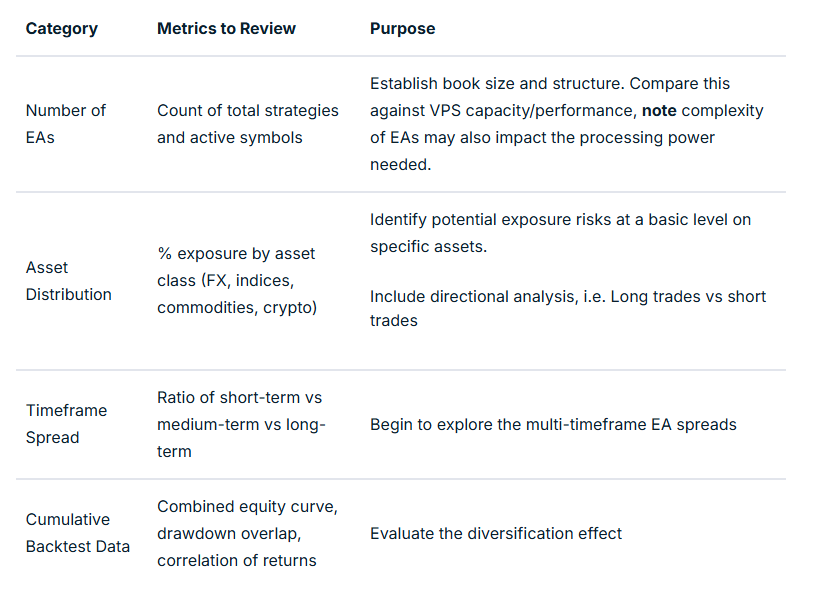
Temporal (timeframe) Balancing
When combined, a timeframe balance (even on the same model and instrument) can help flatten equity swings.
For example, a losing phase in a fast-acting M15 EA can often coincide with a profitable run in an H4 trend model.
Combining this with some market regime and sessional analysis can be beneficial.
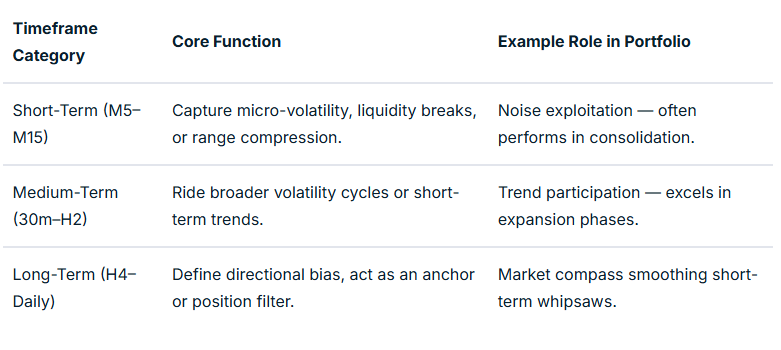
Asset Balance: Managing Systemic Correlation Risk
Running five different EAs on USDJPY might feel diversified if each uses different entry logic, even though they share the same systemic market driver.
But in an EA context, correlation measurement is not necessarily between prices, but between EA returns (equity changes) relating to specific strategies in specific market conditions.
Two EAs on the same symbol might use completely different logic and thus have near-zero correlation.
Conversely, two EAs on a different symbol may feel as though they should offer some balance, but if highly correlated in specific market conditions may not achieve your balancing aim.
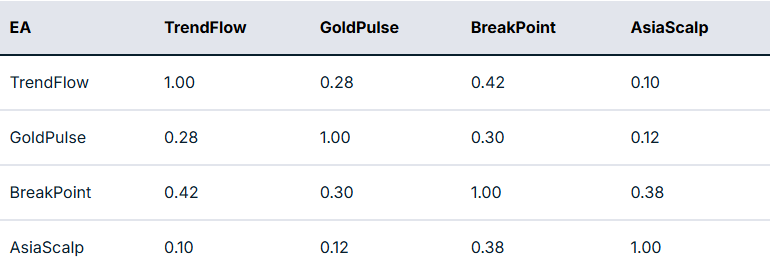
In practical terms, the next step is to take this measurement and map it to potential actionable interventions.
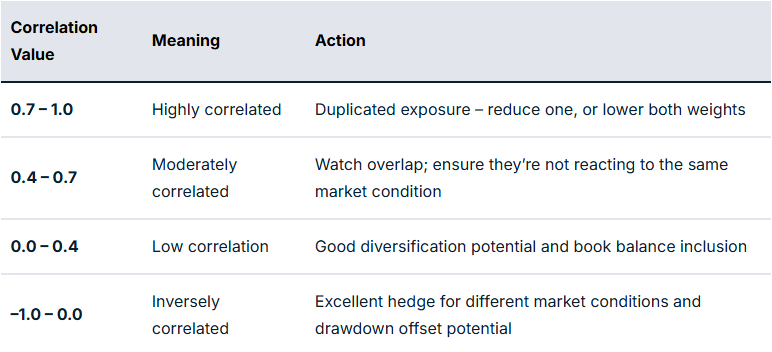
For example, if you have a EURUSD Trend EA and a GBPUSD Breakout EA with a correlation of 0.85, they are behaving like twins in performance related to specific market circumstances. And so you may want to limit exposure to some degree if you are finding that there are many relationships like this.
However, if your gold mean reversion EA correlates 0.25 compared to the rest of your book, this may offer some balance through reducing portfolio drawdown overlap.
Directional and Sentiment Balance
Markets are commonly described as risk-on or risk-off. This bias at any particular time is very likely to impact EA performance, dependent on how well balanced you are to deal with each scenario.
You may have heard the old market cliché of “up the staircase and down the elevator shaft” to describe how prices may move in alternative directions. It does appear that optimisation for each direction, rather than EAs that trade long and short, may offer better outcomes as two separate EAs rather than one catch-all.
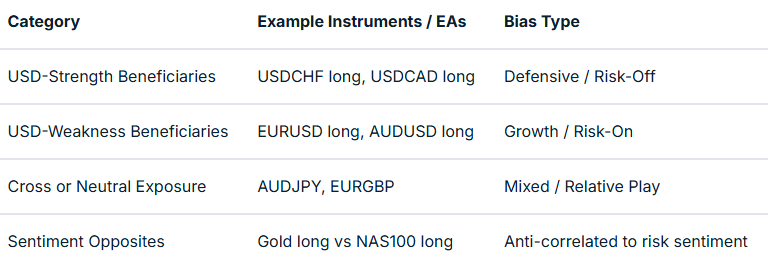
Market Regime and Volatility Balance
Trend and volatility states can have a profound impact on price action, whether as part of a discretionary or EA trading system. Much of this has a direct relationship to time of day, including the nature of individual sessions.
We have a market regime filter that incorporates trend and volatility factors in many EAs to account for this. This can be mapped and tested on a backtest and in a live environment to give evidence of strategy suitability for specific market conditions.
For example, mean reversion strategies may work well in the Asian session but less so in strongly trending markets and the higher volatility of the early part of the US session.
As part of balancing, you are asking questions as to whether you actually have EA strategies suited to different market regimes in place, or are you using these together to optimise book performance?
The table below summarises such an approach of regime vs market mapping:
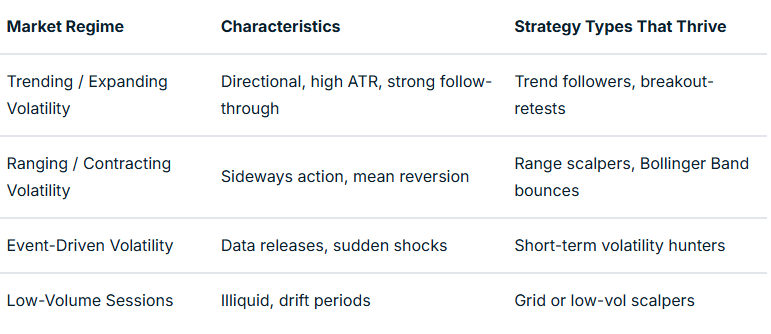
Multi-Level Analysis: From Composition to Interaction
Once your book is structured, the challenge is to turn it into something workable. An additional layer of refinement that turns theory and measurement into something meaningful in action is where any difference will be made.
This “closing the circle” is based on evidence and a true understanding of how your EAs are behaving together. It is the step that takes you to the point where automation can begin to move to the next level.
Mapping relationships with robust and detailed performance evaluation will take time to provide evidence that these are actually making a difference in meeting balancing aims.
To really excel, you should have systems in place that allow ongoing evaluation of the approaches you are using and advise of refinements that may improve things over time.
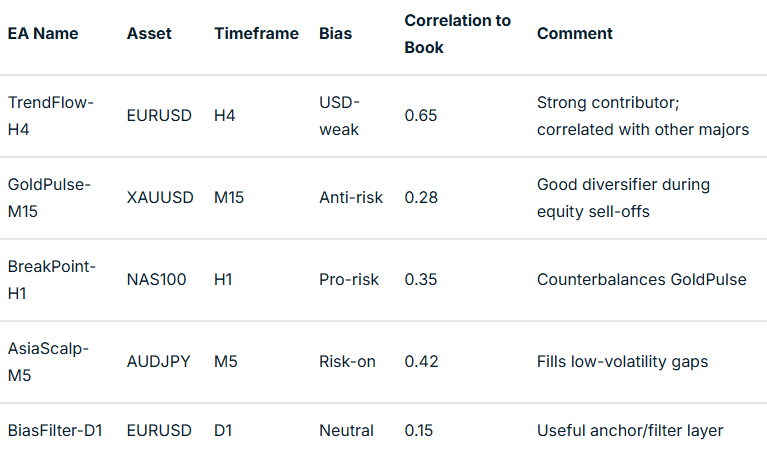
What Next? – Implementing Balance in Practice
Theory must ultimately translate into an executable EA book. A plan of action with landmarks to show progress and maintain motivation is crucial in this approach.
Defining classification tags, setting risk weights, and building monitoring dashboards are all worth consideration.
Advanced EA traders could also consider a supervisory ‘Sentinel’ EA, or ‘mothership’ approach, to enable or disable EAs dynamically based on underlying market metrics and external information integrated into EA coding decision-making.
Final Thoughts
A balanced EA portfolio is not generated by accident; it is well-thought-out, evidence-based and a continuously developing architecture. It is designed to offer improved risk management across your EA portfolio and improved trading outcomes.
Your process begins with mapping your existing strategies by number, asset, and timeframe, then expands into analysing correlations, directional bias, and volatility regimes.
When you reach the stage where one EA’s drawdown is another’s opportunity, you are no longer simply trading models but managing a system of EA systems. To finish, ask yourself the question, “Could this approach contribute to improved outcomes over time?”. If your answer is “yes,” then your mission is clear.
If you are interested in learning more about adding EAs to your trading toolbox, join the new GO EA Programme (coming soon) by contacting [email protected].


The rise of algorithmic trading has made it possible for traders of all levels to execute trades with precision and discipline 24/7.
However, while algorithms, such as Expert Advisors (EAs) used on MT4or MT5, remove emotion from the execution, they cannot remove the human element from trading.
The psychological challenges may be different when using EAs than those facing the discretionary trader, but challenges still exist.
Every automated strategy reflects the trading beliefs, thinking, logic, and discipline of its creator. This is true in development and in a live environment.
The “code” in EA trading should mean more than lines of MQL5. It should be based on a code of conduct that defines the standards by which you operate.
In a world where automation can amplify both success and mistakes, a structured set of principles helps ensure EAs remain a tool for improvement, not a shortcut to risk.
1. Use EAs as Trading Tools, Not Replacements for Good Practice
EAs are instruments, tools of the trade, not a replacement for skill, judgment, or responsibility. Their role is to supplement a trader’s edge, not substitute for it.
For example, a swing trader who relies on price-action patterns might automate only specific entry conditions to ensure consistency, while continuing to manage exits manually.
Conversely, a systematic trader may automate the entire process but still monitor performance against broader market regimes as a filter for entering or exiting automated trades.
Before an EA is ever switched on, traders must ask: What problem is this solving for me? Is it improving my execution discipline, making sure I miss fewer trading opportunities, or helping me diversify and trade efficiently across multiple markets?
Automation magnifies intent and thoroughness in peroration, execution and system refinement. If your answer is simply “to make money while I sleep,” the foundation is not enough, and perhaps you should look a little deeper.
2. Design with Clarity and Thoroughness
The design phase is where your EA professionalism begins. Every EA must be built on a clear, rules-based logic that matches the trader’s intent and desire to take advantage of specific price action.
In practice, this means you need to define exactly what the EA is supposed to do from the outset and, equally, what it will not do.
Integrity in design means documenting your logic before you code it. Write out the concept in plain language.
“Enter long when a bullish engulfing candle forms above the 20 EMA during the London session.”
“Exit when RSI crosses below 70 or after two ATRs in profit.”
Once defined, those conditions become the contract between the trader and the code.
Whether you are attempting to code yourself, using a third party to code for you or even using an off-the-shelf EA, ambiguity or lack of clarity should be addressed.
Without this, there will always be a temptation to shift or a failure to recognise the need for refinement.
3. Test with Transparency
Backtesting is often where enthusiasm overtakes discipline. It’s easy to be seduced by an impressive equity curve, yet testing is only valuable when it’s transparent.
Successful EA traders will often treat every backtest as additional data, not exclusive hard validation that an EA definitely perform in a live market environment.
They record settings, market conditions, and measure key metrics, saving results journal and different versions. This allows an objective comparison and sets the foundations for what should be measured on an ongoing basis.
Transparency also means using realistic conditions — spreads, slippage, and ticks rather than OHLC for final testing, all provide a greater quality of metrics that may more accurately mirror live trading.
A good practice is to maintain a “testing log” alongside the EA code. For example:
- Version number
- The purpose of the test (e.g., confirm logic or optimise ATR period for setting stop or take profit levels)
- The conditions under which it was run, including underlying market conditions and arguably directional and sessional differences.
- The interpretation of results (what was learned, not just the numbers)
4. Avoid the Illusion of Certainty
The temptation to fine-tune parameters until a backtest looks flawless is a trap known as overfitting.
It produces systems that may often perform brilliantly on historical data but collapse in a heap in live markets, where other external variables can be equally, if not more influential.
The necessity for and rigour and robustness in testing include approaches such as:
- Forward testing: Running the EA on new data to confirm behaviour.
- Walk-forward analysis: Re-optimising in rolling segments to ascertain whether there is parameter stability.
- Parameter clustering: Checking if profitability holds across a range of values rather than one precise setting. E.g., it will still be profitable if a level of partial close is 40, 50 or 60% of your position.
A robust EA trader accepts uncertainty as reality. A recognition that markets can evolve, conditions often shift, and no single setting is likely to remain optimal forever.
Your goal is durability, not perfection in a single set of market conditions.
An EA that performs moderately well across different conditions is often far more valuable than one that looks brilliant in backtest isolation.
5. Adequate Preparation for Live Execution
The transition from backtest to live trading is not something to take lightly; it is a major operational step. Before going live, traders should have a checklist covering readiness that includes confirmation of logic, appropriate infrastructure, and management of risk.
Steps to achieve this aim can include:
- Running the EA in visual backtest mode to confirm correct trade placement.
- Checking symbol specifications, such as contract size, margin requirement, and swap cost.
- Confirming VPS stability — low latency, sufficient processing power for the number of EAs you are trading, and reliability
- Testing on a demo account first, under live market conditions and then move to a live environment using minimum trading volume before scaling.
EA traders should have a set of minimum values for key metrics such as Net profit vs balance drawdown, win rate, consecutive wins and losses and Sharpe ratios before moving to live.
A full checklist that incorporates minimum testing performance as well as infrastructure management is critical.
6. Manage Risk is About You, Not Your EA
The most dangerous misconception in automated trading is that the EA “handles risk.” It does not. It simply executes your instructions, whether these are good or bad for a particular trade.
As a trader, you remain responsible for every lot size, margin call, and equity swing. Proper capital management means understanding total exposure across all running EAs as a whole, not just an individual one.
Running five EAs, of which risks 1% of account equity per trade is not necessarily diversification, particularly if the assets are heavily correlated.
In the same way that you should be rigorous in decision-making from test to live environment, it is equally important when scaling, i.e., increasing trading lot sizes.
Scaling rules should be data-based and only considered after a defined critical mass of trading activity of a single EA. Only increasing trade size when the EA’s equity curve maintains a positive slope over a rolling period, or when the profit factor exceeds a set threshold for a given number of trades.
Once scaling is taking place beyond the minimum volume, it may be worth considering the implications of the reality that risk is dynamic.
Experimenting with adjusting lot size against the strength of the signal or underlying market conditions for specific EAs may be worthwhile.
7. Monitor, Measure, and Refine
A live EA is not a “set-and-forget” machine. It’s a continuous process that requires observation and refinement on an ongoing basis
Regular and planned reviews of EA performance through appropriate reporting will always reveal valuable insights beyond your overall account balance. Aim to answer questions such as:
- Is the EA behaving as designed?
- Are trade times and volumes consistent with expectations?
- Has the average profit per trade decreased, suggesting a changing market structure?
A disciplined EA trader will use these insights to decide when to pause, adjust, or retire an EA. For instance, if a breakout EA consistently loses during low-volatility sessions, the solution might not be “optimise again” but to restrict trading hours within the parameters.
8. Maintain Operational Discipline
Even the best logic fails if your trading environment is unstable or unsuitable. Operational discipline ensures that the infrastructure supporting EAs is reliable, secure, and constantly monitored for any “events” that may influence the execution of your book of EAs.
This includes maintaining a properly configured VPS (Virtual Private Server) with sufficient CPU capacity and regular monitoring of resource use.
Traders should track activity, confirming that log files are saving correctly, and not only know how to install their EA to trade live (and other files that may be necessary for it to run, e.g., include files) but also how to restart or stop an EA without disrupting open trades.
Operational discipline also extends to record-keeping and organisation of your automated trading performance evaluations and resources. Notes on anything that looks unusual for further review, and systems that dictate when you take actions, are all part of putting the right things in place.
Final Thoughts
Your Code of Conduct for EA Traders is not a rulebook but a roadmap for moving towards excellence in the design, deployment, and management of automated trading systems.
Although each standard can stand alone as something specific to work on, they are also inextricably linked to the whole.
View your automated trading as an extension of who you are and want to become as a trader. An EA can execute your edge, but it cannot replace your accountability for actions, your need for learning and improvement, nor your commitment towards better trading outcomes.
The best traders don’t just build and use algorithms; they build standards of practice and follow through to move towards becoming a successful EA trader.
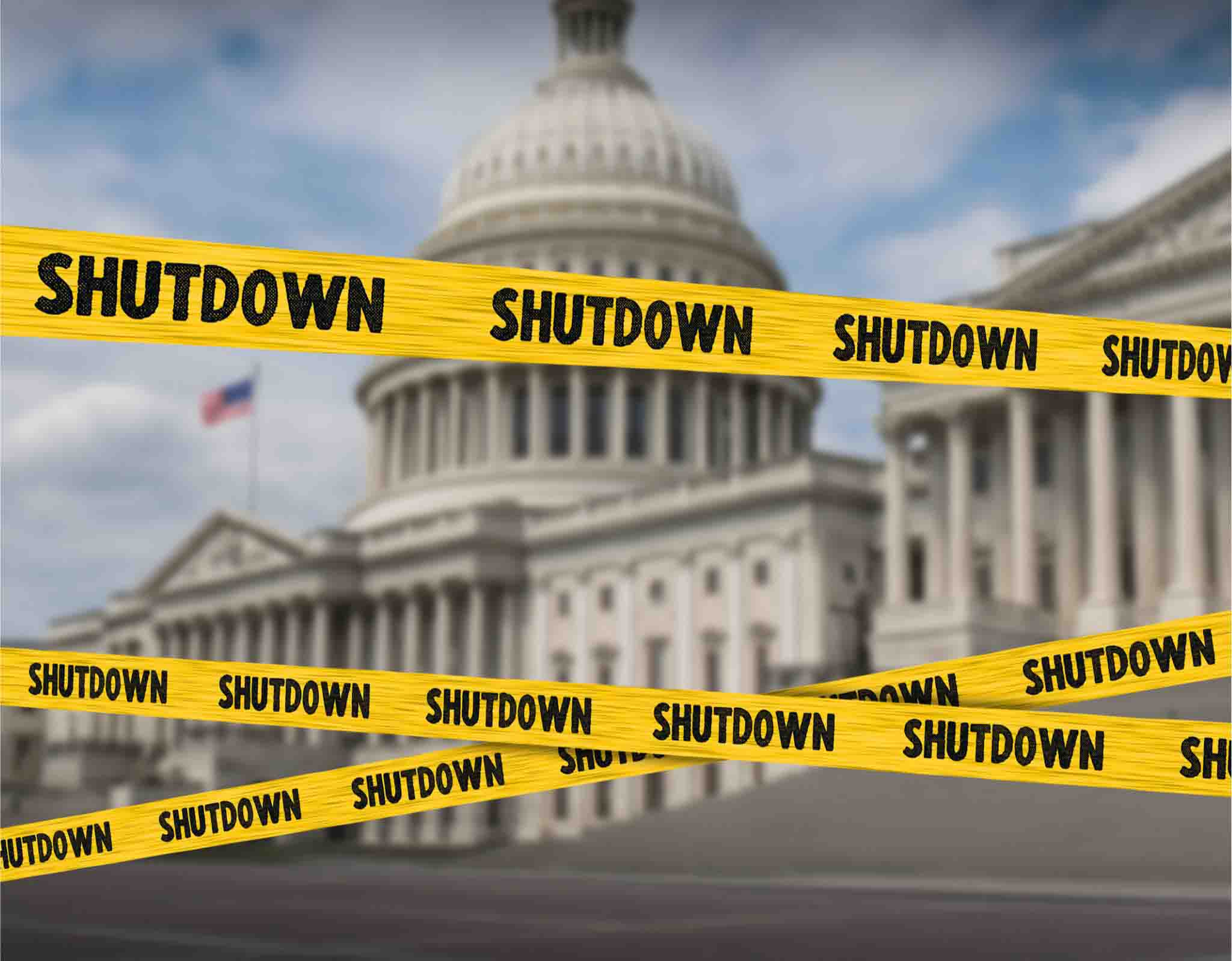

The United States entered a government shutdown on October 1, 2025, after Congress failed to agree on full-year appropriations or a short-term funding bill. Although shutdowns have occurred before, the timing, speed, scale, and motives behind this one make it unique. This is the first shutdown since the last Trump term in 2018–19, which lasted 35 days, the longest in history.For traders, understanding both the mechanics and the ripple effects is essential to anticipating how markets may respond, particularly if the shutdown draws out to multiple weeks as currently anticipated.
What Is a Government Shutdown?
A government shutdown occurs when Congress fails to pass appropriation bills or a temporary extension to fund government operations for the new fiscal year beginning October 1.Without the legal authority to spend, federal agencies must suspend “non-essential” operations, while “essential” services such as national security, air traffic control, and public safety continue, often with employees working unpaid until funding is restored.Since the Government Employee Fair Treatment Act of 2019, federal employees are guaranteed back pay to cover lost wages once the shutdown ends, although there has been some narrative from the current administration that some may not be returning to work at all.
Why Did the Government Shutdown Happen?
The 2025 impasse stems from partisan disputes over spending levels, health-insurance subsidies, and proposed rescissions of foreign aid and other programs. The reported result is that around 900,000 federal workers are furloughed, and another 700,000 are currently working without pay.Unlike many past standoffs, there was no stopgap agreement to keep the government open while negotiations continued, making this shutdown more disruptive and unusually early.
Why an Early Shutdown?
Historically, most shutdowns don’t occur immediately on October 1. Lawmakers typically kick the can down the road with a “Continuing Resolution (CR)”. This is a stopgap measure that can extend existing funding for weeks or months to allow time for an agreement later in the quarter.The speed of the breakdown in 2025, with no CR in place, is unusual compared to past shutdowns. It suggests it was not simply budgetary drift, but a potentially deliberate refusal to extend funding.
Alternative Theories Behind the Early Shutdown
While the main narrative coming from the U.S. administrators points to budget deadlock, several other theories are being discussed across the media:
- Executive Leverage – The White House may be using the shutdown as a tool to increase bargaining power and force structural policy changes. Health care is central to the debate, funding for which was impacted significantly by the “one big, beautiful bill” recently passed through Congress.
- Hardline Congressional Factions – Small but influential groups within Congress, particularly on the right, may be driving the shutdown to demand deeper cuts.
- Political Messaging – The blame game is rife, despite the reality that Republican control of the presidency, House, and Senate, as well as both sides, is indulging in the usual political barbs aimed at the other side. As for the voter impact, Recent polls show that voters are placing more blame on Republicans than Democrats at this point, though significant numbers of Americans suggest both parties are responsible
- Debt Ceiling Positioning – Creating a fiscal crisis early could shape the terms of future negotiations on borrowing limits.
- Electoral Calculus – With midterms ahead, both sides may be positioning to frame the narrative for voters.
- Systemic Dysfunction – A structural view is that shutdowns have become a recurring feature of hyper-partisan U.S. politics, rather than exceptions.
Short-Term Impact of Government Shutdown
AreaImpactFederal workforceHundreds of thousands have been furloughed with reduced services across various agencies.Travel & aviationFAA expects to furlough 11,000 staff. Inspections and certifications may stall. Safety concerns may become more acute if prolonged shutdown.Economic outputThe White House estimates a $15 billion GDP loss per week of shutdown (source: internal document obtained by “Politico”.Consumer spendingFederal workers and contractors face delayed income, pressuring local economies. Economic data releaseKey data releases may be delayed, impacting the decision process at the Fed meeting later this month.Credit outlookScope Ratings and others warn that the shutdown is “negative for credit” and could weigh on U.S. borrowing costs.Projects & researchInfrastructure, grants, and scientific initiatives are delayed or paused.
Medium- to Long-Term Impact of Government Shutdown
1. Market Sentiment
Shutdowns show some degree of U.S. political dysfunction. They can weigh on confidence and subsequently equity market and risk asset sentiment. To date, markets are shrugging off a prolonged impact, but a continued shutdown into later next week could start to impact.Equity markets have remained strong, and there has been no evidence of the frequent seasonal pullback we often see around this time of year.Markets have proved resilient to date, but one wonders whether this could be a catalyst for some significant selling to come.
2. Borrowing Costs
Ratings downgrades could lift Treasury yields and increase debt-servicing costs. The Federal Reserve is already balancing sticky inflation and potential downward pressure on growth. This could make rate decisions more difficult.
3. The Impact on the USD
Rises in treasury yields would generally support the USD. However, rising concerns about fiscal stability created by a prolonged shutdown may put further downward pressure on the USD. Consequently, it is likely to result in buying into gold as a safe haven. With gold already testing record highs repeatedly over the last weeks, this could support further moves to the upside.
4. Credibility Erosion
Repeated shutdowns weaken the U.S.’s reputation as the world’s most reliable borrower. With some evidence that tariffs are already impacting trade and investment into the US, a prolonged shutdown could exacerbate this further.
What Traders Should Watch
For those who trade financial markets, shutdowns matter more for what they could signal both in the short and medium term. Here are some of the key asset classes to watch:
- Equities: Likely to see volatility as political risk rises, and the potential for “money off the table” after significant gains year-to-date for equities.
- U.S. Dollar: With the US dollar already relatively weak, further vulnerability if a shutdown feeds global doubts about U.S. fiscal stability.
- Gold and other commodities: May continue to gain as hedges against political and credit risk. Oil is already threatening support levels; any prolonged shutdown may add to the bearish narrative, along with other economic slowdown concerns
- Outside the US: With the US such a big player in global GDP, we may see revisions in forward-looking estimates, slingshot impacts on other global markets and even supply chain disruptions with impact on customs services (potentially inflationary).
Final Word
The 2025 shutdown is unusual because of its scale and because it started on Day 1 of the fiscal year, without even a temporary extension. That speed points to a deeper strategic and political contribution beyond the usual budget wrangling that we see periodically.For traders, the lesson is clear: shutdowns are not just what happens in Washington, but may impact confidence, borrowing costs, and market sentiment across a range of asset classes. In today’s world, where political credibility is a form of capital, shutdowns have the potential to erode the very foundation of the U.S.’s role in global finance and trade relationships.


Some traders consider entry on the initial retest after the breakout, but (arguably) the higher probability setup is with confirmation that the breakout has failed. Typically, this is confirmed when price closes back through the breakout level and invalidates the initial breakout candle.Psychologically, this reflects the point where breakout traders are trapped, forced to exit, while contrarian traders seize the opportunity. The failed breakout acts as a battleground of conviction — and once the breakout direction is rejected, momentum often flips strongly in the opposite direction.
What Is a Fake-out Reversal?
The “Fake-out Reversal” is a common price action setup that is based on two important price action principles:
- Markets often create the illusion of a breakout at key support or resistance levels.
- A significant number of these breakouts lack conviction, trapping breakout traders before reversing sharply back into the prior range.
Bearish Fake-out Reversal
A bearish Fake-out Reversal setup occurs when resistance appears to have broken to the upside, only for the price to fail and reverse lower back into the range.

- A: Break → price pushes above resistance, suggesting strong buyer control.
- B: Retest → price pulls back to the breakout level, holding temporarily as support.
- C: Fail / Fake-out → the retest is rejected and a bearish candle close occurs beneath the original breakout level or breakout candle low, signalling buyers have lost conviction and sellers are regaining control.
This sequence reflects the inability of buyers to sustain price above resistance, while sellers use the failure to drive price lower.You can see a real chart example of this on the 1-hour EURUSD, where resistance was briefly breached, retested, and then price reversed sharply back below the level.
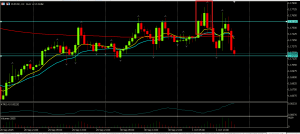
Bullish Fake-out Reversal
A bullish setup occurs when support appears to have broken to the downside, only for price to fail and reverse higher back into the range.
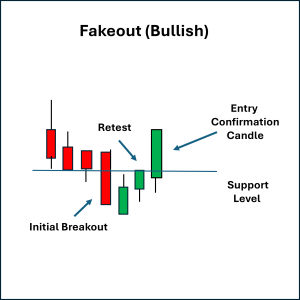
- A: Break → price falls through support, suggesting strong seller conviction.
- B: Retest → price rallies back to the breakout level, holding temporarily as resistance.
- C: Fail / Fake-out → the retest is rejected and a bullish candle close occurs above the original breakout level or the breakout candle high, signalling sellers have lost conviction in the breakout, and buyers are regaining control.
This sequence reflects sellers’ inability to keep price beneath support, and buyers use the breakout failure to force a reversal higher.You can see a real chart example of this on the hourly AUDUSD chart, where a false breakdown beneath support was reversed by strong bullish candles reclaiming the level.
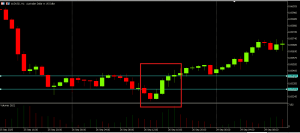
Stop Placement and Exits
Risk management for the Fake-out Reversal often focuses on the failed breakout zone itself:
- For bearish setups, stops are commonly placed just above the retest wick or above the breakout candle high.
- For bullish setups, stops are typically set just below the retest wick or the breakout candle low.
Profit-taking exit approaches can include:
- Using fixed risk-to-reward targets, often 2:1 or better.
- Profit targets can be set near the opposite side of the range or the next key support/resistance level.
- Employing trailing stops (e.g., ATR levels) to capture extended reversals after strong fake-outs.
Final Thoughts
The Fake-out Reversal combines the illusion of a breakout with the confirmation of failure, allowing traders to capture momentum when trapped participants may choose to exit. Structured stop placement at the failed breakout zone and clear profit targets at opposing levels are logical exits to consider.The psychology is rooted in market participants’ vulnerability — breakout traders caught on the wrong side are forced to close, enabling an increase in momentum in the reversal direction.As always, confluence factors such as volume spikes, higher timeframe trend alignment, and time-of-day/session context can add confidence in the likelihood of a reversal.Review your own charts across multiple timeframes and assets for examples of false breaks. Marking these and watching how often they lead to strong reversals could provide clues as to what to include as trading plan criteria.


Forex, index and commodity CFD markets are technically open 24 hours a day, but in terms of market action, not all hours are the same. We can see wide variations in liquidity, volatility, and opportunity depending on which global financial centres are active and the key assets being traded. For intermediate traders, understanding and adopting session dynamic thinking can help you anticipate when volatility will increase, when liquidity will shift, and how market psychology changes from one session to another. Rather than your strategies fighting against these market character variations, you can make efforts to align with them. Adapting your trading approaches during the windows when markets are most likely to provide structured opportunities for whichever strategies you choose to use.
Why Sessional Awareness Matters to Traders
Although trading never stops, it’s misleading to think the market is evenly active. The depth of orders resulting in increases in trading volume, the aggression of institutional flows, and the behaviour of price can all depend on the time of day.
- Liquidity: Liquidity isn’t evenly distributed throughout the day. At quiet times, spreads may widen and levels hold more easily. At busy times, volume surges, spreads tighten, traders clamour to position, and key levels are more likely to break as new information is processed.
- Volatility: The price moves differently depending on the session. Asia often tends to consolidate, London often ignites trends, and data releases and Wall Street trading flows associated with the New York session result in changes in volatility as markets recalibrate.
- Market psychology: Much of the sessional character can be (arguably) influenced by the fact that each region has different participants with their own unique priorities that can change the “tone” of the market. e.g. Japanese and other Asian country exporters, European banks, US fund managers and major institutions.
Characteristics of the Three Major Sessions
1. Asian Session (Tokyo & Sydney)
- Hours (GMT): 11 pm – 8 am
- Key markets: JPY pairs, AUD, NZD, Nikkei, ASX, commodities linked to Asia-Pacific (iron ore, gold during Asian hours).
- Personality: Quiet, range-bound, thinner liquidity.
Characteristics and behaviour:
- The Asian session often creates tight price ranges that act as reference points for later sessions.
- Institutional participation is lighter compared to London and New York, so breakouts are less frequent.
- Despite the “calmer” nature, price moves can still occur, especially as a result of a major regional catalyst like Bank of Japan policy changes, Australian employment data, or Chinese economic releases.
Trading Opportunities:
- Range trading: Support and resistance levels that form in Asia tend to hold throughout the session once established. This could make it ideal for mean-reversion setups.
- Position building: Some traders may choose to pre-position ahead of London, placing smaller trades at the edges of Asian ranges in some expectation of a bigger move when Europe opens.
- News spikes: Watch for scheduled releases like BOJ statements, Chinese PMIs or GDP numbers, which can briefly shake up the otherwise relatively calm price action state. Vigilance to stay abreast of when such potentially globally impacting economic data is due can be a worthy part of your daily routine as you start your trading day.
Asian Session Risks and Psychology:
- False breakouts are common in markets where thin liquidity is in play.
- Premature exits may be triggered due to stop hunts near Asian highs/lows, especially as in lower volatility environments, traders may be tempted to place stop loss levels closer to price action.
- Asia can be thought of as the market’s “warm-up” for the whole trading day. Moves may be modest in comparison to other sessions, but they may leave footprints (ranges, levels) that London and New York can later react to.
2. London Session
- Hours (GMT): 7 am – 4 pm
- Key markets: GBP, EUR, CHF, European indices (DAX, FTSE, CAC40). LME open for commodities
- Personality: Higher liquidity is evident as more traders enter the market and increased institutional flows occur with sharper volatility and velocity in price moves.
Characteristics and behaviour:
- The London open (8 am GMT) often sets the day’s tone. Big banks and funds influence market activity with overnight orders.
- Breakouts of the Asian trading range may be common and attractive to traders looking for the start of new trends
- UK and Eurozone economic data is typically released early in the session, sparking more trading interest with repositioning and recalibration of expectations and valuations across a range of asset classes. Influence on US index futures, CFDs, and metals prices may also be seen.
Opportunities:
- London Breakout: Traders can mark Asian session highs/lows and trade the breakout when London flows in.
- Trend days: If momentum increases throughout the session, London can essentially kick-start moves that may then persist into the New York open.
- News trades: UK GDP, Eurozone inflation, or ECB statements often act as triggers.
Risks and Psychology:
- The London open can be extremely volatile. Breakouts may reverse quickly as early enthusiasm wanes if trading volume is not sustained. This could be evidence of a lack of conviction in some price moves.
- Even though spreads may narrow, stops can still easily occur due to fast swings in price compared to the end of the Asian session.
- London traders are generally thought of as more aggressive, and strong intraday price moves may be established. The increased liquidity often means moves are more reliable but also may be faster, meaning hesitation could be costly.
3. New York Session
- Hours (GMT): 12 pm – 9 pm
- Key markets: USD, Wall Street indices (S&P, Dow, Nasdaq), commodities (oil, gold).
- Personality: Event-driven, volatile, may often whipsaw, particularly around the midpoint of the session or if there is middle-of-the-day news, e.g., Fed interest rate decisions.
Characteristics and behaviour:
- The New York open (12–2 pm GMT) often sees strong moves as US traders react to overnight developments.
- High-impact economic data, e.g. CPI, Non-farm payrolls, are released during the early part of the New York session, usually an hour before equity markets open. This can not only produce sharp swings pre-market but also see an exaggeration of these once the equity market opens at 9.30 am.
- The London–New York Overlap is noteworthy. This is when trading volume is at its highest, and this overlap can often deliver the day’s largest directional moves. With European markets closing around the midpoint of the US trading session, this may explain to some degree the change in trend direction that often occurs around this time.
Opportunities:
- Continuation trades: If London markets have established a trend, then New York will often extend this, particularly if US data releases are consistent with the prevailing trend.
- Reversals: US traders sometimes fade (pull back) on London moves if there is the perception of mispricing with indicators suggestive of being overbought or oversold.
- Event trades: US data releases can provide clear catalyst-driven setups as markets recalibrate to new information.
Risks and psychology:
- Price action can be whippy intra-session, with intraday reversals catching trend-followers off-guard.
- Key news, both expected via data or less predictable potential US policy announcements, can override technical setups in a heartbeat. Trail stops are invariably justified, and pre-emptive action before data release may be worth consideration.
- New York price action reflects both institutional momentum and speculative short-term trading with high volume. It can provide big moves, but traders need to exercise some flexibility as sentiment may change quickly.
SessionHours (GMT)PersonalityBest StrategiesKey RisksAsian (Tokyo/Syd)11 pm – 8 amQuiet, range-boundRange trading, pre-London setupsFalse breakouts, low liquidityLondon7 am – 4 pmVolatile, trendingBreakouts, trend trades, newsFast swings, stop-outsNew York12 pm – 9 pmEvent-driven, mixedContinuations, reversals, eventsWhipsaws, news overridesOverlap12 pm – 4 pmMost volatile/liquidMomentum, event trading, breakoutsSlippage, execution stress
Example Trading Approaches by Session
1. London Breakout of the Asian Range
- Logic: The Asian session creates a box (high and low). When London opens, liquidity surges and price often breaks out of this range.
- Execution: Mark Asian highs and lows on your chart. Enter long if London breaks above the Asian high with momentum, consider a short trade if it breaks below.
- Confirmation: Volume spikes or a strong candle close beyond the range.
- Risk management: The stop placement is often just inside the opposite side of the range.
- Psychology: Requires patience, many traders get chopped by false early moves, so using other indicators for confluence may be prudent
2. London Open Reaction
- Logic: The first 30–60 minutes of London can produce false moves as overnight orders are filled.
- Execution: Instead of trading the immediate breakout, wait to see whether the first push holds or reverses. The breakout and retest approach may offer some more robust confirmation of a move that may be sustained. Trading price reversion to a previous state with false breakouts as prices move back into the trading range may also be worth looking for as a potential set-up.
- Example: If GBP/USD spikes down on open but fails to hold below Asian lows, a long trade back inside the range may be cleaner.
- Risk management: Use stops that are consistent with key levels
- Psychology: Having the discipline to avoid chasing the first candle and waiting for confirmation may be worth consideration, and seeing this as more important than perhaps the fear of missing out on a few extra pips in a less certain trend move.
3. Overlap Momentum
- Logic: During the London–New York overlap, trends are strongest. If the price breaks a level here, the continuation probability is higher.
- Execution: Trade breakouts, particularly subsequent to data releases during the overlap, can be significant. Entry is based on being decisive on evidence of continued momentum.
- Tools: Shorter timeframes (M5/M15) with VWAP or volume confirmation may be considered, not only for entry but potentially for timely exits.
- Risk management: Use of aggressive trailing stops and /or partial closes may help lock in some profit as price moves in your desired direction. Reversals can be sudden, and there is a strong chance of giving significant portions of profit back to the market without these approaches.
- Psychology: Fast execution and confidence to follow through on your pre-planned trading system are critical. Hesitation can mean both missed entries and poorly timed exits.
4. Fade the New York Afternoon
- Logic: After the midday close of the European markets and a lessening in momentum as the New York close comes into sight, intraday traders will often square positions, leading to reversals from early trading day extremes.
- Execution: Identify when the price has extended far from the session mean. Look for signs of exhaustion (candlestick rejection, momentum loss) and move back into Bollinger bands after a foray outside the upper or lower bands.
- Example: If EUR/USD rallies all day but stalls near resistance during the afternoon session in the US, a potential mean reversion may be on the cards.
- Risk management: Smaller trade sizes may be prudent as liquidity falls and the chance of rapid reversals increases.
- Psychology: Although patience is key in using trails and logical profit targets to enable profit to run, don’t be tempted to ride the potential for further moves up if there is some evidence that reversal signs may be increasing.
Key Considerations for Session Trading
- Time zone alignment: Always convert session opens into your broker’s server/platform time. Mistakes here cause mistimed trades. Give our support team a ring if you need clarity on when this happens, and of course, take into account changes in daylight saving time.
- Volatility filters: Use ATR to size stops and targets differently by session. A 20-pip stop may be fine in Asia, but it may be far too tight for the London session price action.
- News awareness: Many moves are data-driven. Never enter blindly around a scheduled release and have a pre-planned approach for exit, e.g., close before data, partial close, ride it out, that is right for your individual risk profile and trading objectives.
- Lifestyle fit: You don’t have to trade all sessions. Many successful traders specialise in one (e.g., London mornings or New York overlap), trading should aim to add to your lifestyle, not dictate it.
Final thoughts
Trading isn’t only about setups; it’s arguably equally important to consider timing. Developing a greater understanding of the individual maturity of global trading sessions, traders can anticipate when liquidity and volatility are likely to rise and fall, structure trade planning accordingly, and better mitigate the risks associated with these changes in market action through the trading day.Make your trading approaches not only right for respective market sessions but right for you. You can choose to master one session and then expand or trade all these accounts for changes in approach within your trading plan. As with most trading approaches, the key to sustainable positive outcomes is consistent measurement. Looking at trades and strategies by session may give clues as to what you can refine.

